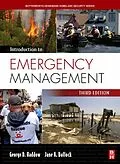Introduction to Emergency Management, Third Edition provides a comprehensive update of this foundational text on the background components and systems involved in the management of disasters and other emergencies. The book details current practices, strategies, and the key players involved in emergency management, especially in the U.S. but also around the world. Expanded coverage of local and state issues, particularly as they need to interact and work with FEMA and other federal agencies, adds value to public administrators locally tasked with protecting their community. The Third Edition is fully updated to cover FEMA's continually changing role within the Department of Homeland Security and the impact and aftermath of Hurricane Katrina. Lessons including proper planning, mitigation, in-crisis decisions, evacuation, and recovery shed light on how managers can avoid devastating breakdowns in communication and leadership during an event. Not only terrorist events but many such natural disasters require similar preparedness planning. Emergency planning is vital to the security of entire communities and thus an essential focus for research, planning and training. This new edition continues in its tradition of serving as an essential resource for students and young professionals in the discipline of Emergency Management. - Case examples provide current specific examples of disasters and how they were managed - Full-color hurricane Katrina section with event timeline - Written by 2 former FEMA senior officials who draw on firsthand experience in day-to-day emergency management operations
Autorentext
Jane A. Bullock served more than 20 years in support of Federal emergency management efforts, culminating as the Chief of Staff at the Federal Emergency Management Agency (FEMA) for Director James Lee Witt. In this position Ms. Bullock served as principal advisor to the Director on all Agency programmatic and administrative activities; provided advice and recommendations to the Director on policies required to carry out the mission of the agency; managed the day-to-day operations of the Agency; directed, monitored, and evaluated Agency strategic and communication processes; and oversaw administration of the Agency's resources, including the disaster relief fund. In 2001, Ms. Bullock co-founded the disaster management consulting firm Bullock & Haddow LLC. She currently serves on the governing boards of the National Earthquake Hazards Program, the Earthquake Engineering Research Center, and others.
Klappentext
Introduction to Emergency Management, Third Edition provides a comprehensive update of this foundational text on the background components and systems involved in the management of disasters and other emergencies. The book details current practices, strategies, and the key players involved in emergency management, especially in the U.S. but also around the world. Expanded coverage of local and state issues, particularly as they need to interact and work with FEMA and other federal agencies, adds value to public administrators locally tasked with protecting their community. The Third Edition is fully updated to cover FEMA's continually changing role within the Department of Homeland Security and the impact and aftermath of Hurricane Katrina. Lessons including proper planning, mitigation, in-crisis decisions, evacuation, and recovery shed light on how managers can avoid devastating breakdowns in communication and leadership during an event. Not only terrorist events but many such natural disasters require similar preparedness planning. Emergency planning is vital to the security of entire communities and thus an essential focus for research, planning and training. This new edition continues in its tradition of serving as an essential resource for students and young professionals in the discipline of Emergency Management.
- Case examples provide current specific examples of disasters and how they were managed
- Full-color hurricane Katrina section with event timeline
- Written by 2 former FEMA senior officials who draw on firsthand experience in day-to-day emergency management operations
Inhalt
1. The Historical Context of Emergency Management
2. Natural and Technological Hazards and Risk Assessment
3. The Disciplines of Emergency Management: Mitigation
4. The Disciplines of Emergency Management: Response
5. The Disciplines of Emergency Management: Recovery
6. The Disciplines of Emergency Management: Preparedness
7. The Disciplines of Emergency Management: Communications
8. International Disaster Management
9. Emergency Management and the New Terrorist Threat
10. The Future of Emergency Management
Katrina: A Case Study
Appendix: Acronyms
